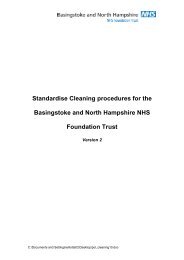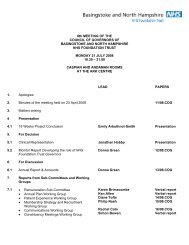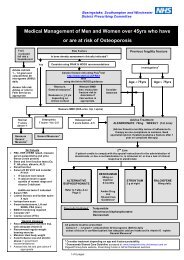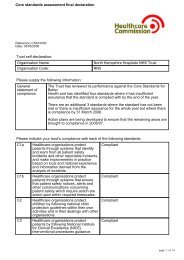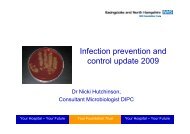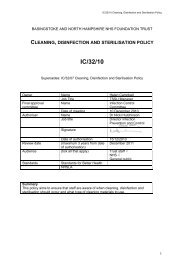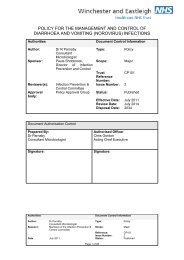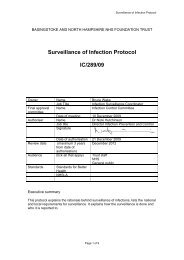Isolation and infectious diseases policy - Hampshire Hospitals NHS ...
Isolation and infectious diseases policy - Hampshire Hospitals NHS ...
Isolation and infectious diseases policy - Hampshire Hospitals NHS ...
Create successful ePaper yourself
Turn your PDF publications into a flip-book with our unique Google optimized e-Paper software.
Winchester & Eastleigh Healthcare <strong>NHS</strong> Trust<br />
Policy for <strong>Isolation</strong> <strong>and</strong> Infectious Diseases Policy<br />
Appendix 2: Notifiable <strong>diseases</strong>, alert organisms <strong>and</strong> alert conditions<br />
Please refer to DOH <strong>and</strong> Health Protection Legislation (Engl<strong>and</strong>) Guidance<br />
2010 (Table 1)Website: http://www.dh.gov.uk/publications<br />
The early reporting of communicable disease is an essential element in the control of<br />
these largely preventable <strong>diseases</strong>. Some may require a prompt <strong>and</strong> immediate<br />
follow up of those affected, whereas others may require a review of the immunisation<br />
status of the affected individual or their close contacts.<br />
Notification of certain <strong>infectious</strong> <strong>diseases</strong> is a statutory duty for the medical<br />
practitioner who makes a provisional or definite diagnosis listed below, as well as<br />
being a valuable tool in the prevention <strong>and</strong> control of disease. The doctor is<br />
statutorily required to notify the Consultant in Health Protection at the Health<br />
Protection Unit.<br />
The hospital doctor must also inform the hospital Infection Prevention <strong>and</strong> Control<br />
team <strong>and</strong> the ward staff so that adequate precautions such as isolation can be<br />
immediately commenced.<br />
The following <strong>diseases</strong> are notifiable (Bold ones require urgent notifications):<br />
Acute encephalitis<br />
Acute meningitis (if bacterial)<br />
Acute poliomyelitis<br />
Acute <strong>infectious</strong> hepatitis (hepatitis A,B,C other)<br />
Anthrax<br />
Avian influenza<br />
Botulism<br />
Brucellosis<br />
Cholera<br />
Diphtheria<br />
Dysentery<br />
Enteric fever (typhoid & paratyphoid fever)<br />
Food poisoning<br />
Haemolytic uraemic syndrome (HUS)<br />
Invasive Group A streptococcal infection<br />
Legionnaires’ disease<br />
Leprosy<br />
Leptospirosis<br />
Malaria<br />
Measles<br />
Meningococcal septicaemia (without meningitis)<br />
22<br />
Authorities<br />
Mumps<br />
Ophthalmia neonatorum<br />
plague<br />
rabies<br />
relapsing fever<br />
rubella<br />
SARS<br />
scarlet fever<br />
small pox<br />
tetanus<br />
tuberculosis<br />
typhus fever<br />
viral haemorrhagic fever<br />
whooping cough<br />
yellow fever<br />
Document Control Information<br />
Author:<br />
Sponsor:<br />
Date:<br />
Dr Kordo Saeed<br />
microbiologist<br />
Sue Dailly Lead Nurse<br />
Infection Prevention <strong>and</strong><br />
Control<br />
Paula Shobbrook Director of<br />
Infection Prevention <strong>and</strong><br />
Control<br />
01/08/11<br />
Type:<br />
Scope:<br />
Reference:<br />
Issue No:<br />
Status:<br />
Policy<br />
Major<br />
CP022 (IC 04)<br />
4<br />
Published



